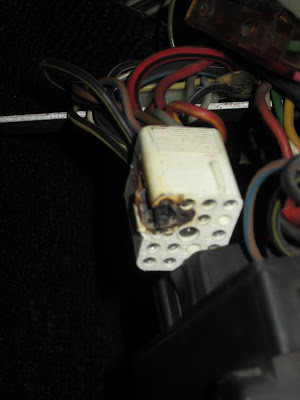About halfway home I get a call from my wife. She say we're going to have quesadillas for dinner tonight, and you know what make a good quesadilla right? Tortillas. So now I've got to stop at the grocery store and now I'm not sure I have enough time to make it home before it's too dark. Well, the motor doesn't work immediately, but sometimes if I leave them on long enough they'll suddenly pop up a few minutes later. Maybe that'll work for me. I rock the switch into the first position, the parking lights go on, and two miles later the headlights decide to go up. Perfect! Now I can just leave them up when I go into the store.
I get to the store and realize I've never really used the headlights, so I'm not sure if they'll want to stay up when I turn off the car. I park, turn off the ignition, and toggle the switch back to off and the headlights stay up, but the parking lights stay on. Funny, but I can probably get in and out of the store before my battery runs dry. I run in, grab the tortillas, and I'm back to the car in 10 minutes. I hop in the car, toggle the switch back to parking lights only, turn on the car, then flip on the headlights...and the headlights flip back down. Dang it! First of all I'd apparently flipped the headlights ON before I went into the store and the lights apparently don't work anymore either, then when I thought I was turning them back on I actually turned them off and now they're stuck down. But I hadn't quite put this together yet.
Well, I've got a ways to go through the parking lot before I actually get on the street, so maybe they'll pop up before I get there. They don't. But there's no traffic, it's not terribly dark, and I'm only two miles from home, so what the heck. I pull out on the street and finally get a stroke of luck. The lights pop up in a quarter mile and the headlights actually turn on this time! I make it to within 100 feet of the house and the lights suddenly flick off again. Sheesh, time to fix the headlights!
Amazingly, I find a website where a guy goes into tons of detail on how to rebuild the motor on a 944 and it looks identical to mine. Here's the motor with the first dust cover removed and manual knob pulled off.
The whole thing is covered in this rubber dust boot, and amazingly it's totally soft still. I figured it would want to just crack and fall apart.
Two screws removed and the case comes off. You can see the commutator (the copper colored thing) is pretty grooved and not very smooth.
There, nice and shiny!
Next step is the switches (which is actually the real problem. How do I know it's the real problem you say? Well, I actually put the motor back together and reinstalled it in the car only to find that it worked exactly as it had before. That's why!). You can see the switch contacts on the right that ride against this plate on the left. There are plastic "interrupters" at the end points of travel that turn them off and on. There was a little bit of tarnish and a few rough spots on the plate, but not much. I sanded it down really nice and applied a really light film of dielectric grease to the surface. The switch contacts had a small amount of stuff built up on them, so I cleaned those too. I honestly didn't think this would make things any better, but it worked perfect after cleaning this stuff up! By the way, don't lose the tiny ball bearing that's in the center of the plate on the right.
Apparently the required number of screwdrivers to complete this job was 5. As time goes by, more and more tools make their way onto the workbench and don't get put away and I eventually clean the whole thing up. There was one time when I counted how many screwdrivers I picked up and it was 18! Apparently that's my favorite tool.
Woo hoo, the lights flip up! Crap, the lights didn't switch on! Well, at least I'll have something to do over the weekend right?





















































